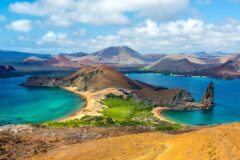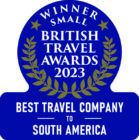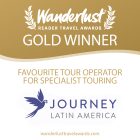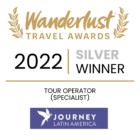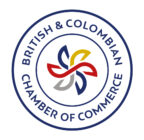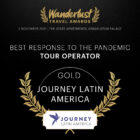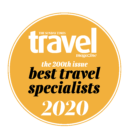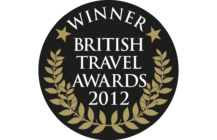
Overview & Highlights
Self-drive in friendly Uruguay, a peaceful little country wedged between Brazil and Argentina. The well-paved, empty roads are a pleasure to drive and you stop off along its unspoilt coast and inland at welcoming ranches and wine lodges.
- Buenos Aires: Walking tour of Montserrat and San Telmo
- Colonia: Guided walking tour with traditional cheese and wine tasting
- Montevideo: Guided walking tour with market barbecue lunch
- Countryside ranch: Self-guided walks
Uruguay, wedged between the behemoths of Brazil and Argentina, is a holiday destination offering a real sense of breathing space. It’s the size of England but with a population of just 3.5 million, not much greater than that of Wales. The gently rolling countryside is dreamily bucolic – the famous beef cattle graze nonchalantly accompanied by a multitude of birds, whose song at sunrise is as enchanting as the unspoilt little towns and increasingly chic range of hotels and restaurants.
Getting around is most satisfyingly achieved with the freedom of your own hire car. Our self-drive holiday explores the UNESCO jewel of Colonia, Carmelo’s vineyards, Montevideo’s art-deco streets, the little-visited interior of Uruguay and the beaches of José Ignacio. There’s about 850km of driving over nine days and you’ll have the support of pre-booked accommodation allowing you to explore at your leisure.
Outline itinerary
Day 1
Arrive Buenos Aires, transfer to your hotel in Recoleta.
Day 2
Guided walking tour in central Buenos Aires.
Day 3
Ferry across the River Plate to Colonia in Uruguay.
Day 4
Collect your hire car, drive to Carmelo at the head of the estuary.
Day 5
Day at leisure at a wine lodge near Carmelo.
Day 6
Drive to Montevideo, Uruguay’s waterfront capital.
Day 7
Guided walking tour of Montevideo.
Day 8
Drive to a traditional rural inn of Uruguay's interior
Day 9
At leisure in the countryside
Day 10
To the coast: Drive to the small and upscale beach resort José Ignacio.
Days 11, 12
At leisure in José Ignacio.
Day 13
Drive back to Montevideo airport to drop off your car and take your international flight.
Itinerary
Day 1
Arrive Buenos Aires, transfer to your hotel in Recoleta.
Arrive in Buenos Aires, an elegant, cultured and cosmopolitan city famed for its interesting museums and the fascinating port district of La Boca, with its cobbled streets and brightly painted houses – it’s where the tango was born. The centre of town is home to the colonial heart, government buildings and churches as well as chic shopping and residential districts which have a nostalgic Parisian feel.
The bohemian quarter of San Telmo is full of quaint old houses interspersed with antiques shops, tango bars and classy restaurants. Slightly further out of the centre is the Recoleta district which is where your hotel is based. Recoleta is even more evocative of the French influence, and was where Evita Perón was laid to rest.

Day 2
Guided walking tour in central Buenos Aires.
Although the modern Buenos Aires skyline is dominated by its mass of high-rise towers, typical of any rapidly expanding 21st century metropolis, at street level it reveals architectural gems and peeling relics which tell a story best appreciated on foot.
The historic neighbourhoods of Montserrat and San Telmo are the focus of your guided walking tour, which includes a visit to the famous Plaza de Mayo, adorned with the Presidential Casa Rosada (Pink House) and ends in San Telmo, with its many antique and bric-a-brac shops, weekend street market and tango clubs.

Day 3
Ferry across the River Plate to Colonia in Uruguay.
Take the hydrofoil ferry across the River Plate to the port of Colonia in Uruguay. Travel along a forest-fringed estuary, dotted with upmarket residences, to this peaceful little port, and its UNESCO-protected historic centre. It’s a real contrast to the hubbub of Buenos Aires.
You’ll have a guided walk to explore this quaint town where the evocative colonial grid of tree-shaded, peaceful lanes is a photographer’s delight. Colonia was founded by the Portuguese, so the architecture is a bit different from the Spanish and French styles of Buenos Aires and elsewhere in Spanish America. Along the way you’ll stop at one of the town’s welcoming little boltholes for a typical Uruguayan snack of wine, bread and cheeses.
Your hotel is in the heart of old Colonia, allowing opportunities to return to your favourite corners of town to linger longer. You might climb the lighthouse for a view over the town and the estuary beyond.

Day 4
Collect your hire car, drive to Carmelo at the head of the estuary.
Uruguay is a tranquil place, its roads beyond the capital are paved, mostly well-maintained and signposted; petrol stations are frequent and local driving standards are (relatively) good. Roads leading to the coast are most busy during the peak summer holiday season of mid-December to late February but elsewhere you should find there is relatively little traffic, especially if you’re accustomed to driving in the UK. You should be in for a relaxing driving experience, where you can confidently make a detour to explore a place off your basic route which tickles your fancy.
Your car will be delivered to your hotel this morning and once on the road, you’ll be heading west to Carmelo (78km, around 1 hour direct), a sleepy little port at the end of the River Plate estuary with a pretty colonial plaza and a waterside promenade. It’s the centre of the wine-producing region and there are several important vineyards in the vicinity, all ensconced in peaceful countryside studded with eucalyptus trees which is a delight to drive through. Spend two nights at a delightful small lodge and winery in an idyllic rural setting near Carmelo.

Day 5
Day at leisure at a wine lodge near Carmelo.
Yesterday was a great introduction to driving in Uruguay but today you may well decide just to hang out around Carmelo and become acquainted with Uruguay’s excellent wines, centering on bold reds – called Tannat – which you’ll find surprisingly different to the Malbecs available across the River Plate. You walk or cycle to local vineyards from the hotel, or visit the little store close by where you can enjoy a glass among the vines.
The sleepy riverside town of Carmelo itself, with its single-storey dwellings shaded by jacaranda trees and churches, is worth a look around: there’s a nice little museum a ruined Jesuit mission from the 18th century.
Day 6
Drive to Montevideo, Uruguay’s waterfront capital.
It’s off on the road back east towards Montevideo, the nation’s capital. You could well stretch the 245km journey to a full day. There are a couple of alternative roads, but in general you’ll be driving through open farmland with vast fields of wheat and soya, the ubiquitous cattle and small farmsteads. Close to the estuary you’ll cross rivulets and marshlands, before you see the Montevideo skyline loom up on the horizon.
Arriving in the capital you’ll discover a lively waterfront city with a great setting, where modern skyscrapers jostle with art deco façades and grand, monumental colonial buildings. For a national capital there’s relatively little traffic or pollution, so you should feel at ease driving through the city to your hotel.
Born of the competing interests of colonial powers, the city, on the shores of a fine natural harbour on the River Plate, grew to be a prosperous port devoted to overseas trade. It attracted immigrants from all of Europe, resulting in an eclectic cultural mix which survives to this day.

Day 7
Guided walking tour of Montevideo.
You’ll have a guided walking tour in the morning, passing through the colonial centre, viewing some of the historic public building and monuments: there’s a distinct retro feel, with many art-deco buildings displaying a faded charm.
You’ll be taken to the port market for lunch: this is a fascinating place, popular among the locals who throng to its open-air bars and restaurants. Here, you can enjoy a steak to rival anything you might have savoured in Buenos Aires, washed down with a local wine.
In the evening you might take a stroll down the beachfront Rambla, where Montevideños may well be out jogging, cycling or roller-skating.

Day 8
Drive to a traditional rural inn of Uruguay's interior
Drive for around 200km north-east of the capital and into the rural department of Lavalleja, with its low hills and rugged countryside. Inland, Uruguay’s roads are startlingly empty, as is the countryside. Much of it is cattle country, dotted with traditional small estancias (ranches) and alive with nature and birdsong.
Uruguay has several delightful country inns which welcome guests with simple lodgings and warm hospitality – a typically Uruguayan experience. Your base for the next couple of days, is a charming small rural inn a few minutes’ drive from the settlement of Mariscala, whose population is under 2,000. Depending on your chosen route, the journey to tonight’s accommodation takes around 3 hours.

Day 9
At leisure in the countryside
El Balcon del Abra offers peaceful landscapes, homely comforts and the charm of a small Uruguayan posada (inn) with only 8 rooms. Located in well-kept parkland dotted with tall palms and deck chairs, it is a fine base to relax for the day or wander off on a self-guided walk. The estancia also offers its guests a complimentary horse ride during their stay. Optional activities which may be available locally include mountain biking, canoeing and 4×4 trips into the surrounding countryside.

Day 10
To the coast: Drive to the small and upscale beach resort José Ignacio.
It’s around 150km to drive today to reach José Ignacio, a cool, sophisticated and affluent coastal resort with upmarket boutiques, art galleries and restaurants yet not at the expense of its charm. The town only has about 300 permanent residents but this number swells by the thousand in the buzzy summer, including socialites, Hollywood stars and international supermodels. They are attracted to the laid-back, low-key atmosphere: there are still some dusty, acacia-shaded lanes with pop-up bars and al fresco celebrity chef eateries – you may be fighting for space with a Porsche if you want to park outside one of these.
You’ll be staying at a hotel around 3km from José Ignacio and just 200m from the beach in a peaceful location away from the relaxed nightlife (discos have to shut at 2am by law).

Days 11, 12
At leisure in José Ignacio.
You have 2 full days at leisure to enjoy the resort’s vibe, sample its fine restaurants and maybe catch up with some sun on the beach.
If you are in the mood for exploration with your hire car, there is no shortage of options. An hour to the west is Uruguay’s most famous beach resort, Punta del Este, with its glorious, sweeping Atlantic beaches, fine restaurants and a very lively atmosphere in summertime.
For something more sedate, head east towards the province of Rocha. One of our favourite parts of Uruguay, Rocha is a picture of utter peace and tranquility. It has some of Uruguay’s most alluring countryside, dotted with old estancia houses, ombu and palm trees. Cabo Polonio National Park, one of Uruguay’s highlights, is around 2-hours drive away. Walking amidst its sand dunes and wild, windy coastline makes for a bracing day out. The remote hamlet of Cabo Polonio itself feels almost cut off from the outside world, with its brightly painted houses, iconic lighthouse, small eateries and sea lion colony. Rocha also has several small beach resorts such as La Pedrera and La Paloma, popular among surfers with a hip nightlife in summer. Meanwhile, its nature reserves and lagoons are great for birding.

Day 13
Drive back to Montevideo airport to drop off your car and take your international flight.
An early start for the 145km drive from José Ignacio to Carrasco airport near Montevideo, which should take around 2 hours.
UK clients arrive home the following day.
Essentials
Tour info
Transport
1 ferry journey (1hr); car hire for 9 days.
Accommodation
We invite you to stay at a variety of accommodation styles, from urban boutique to wine-theme lodge and countryside ranch. Each has individual character and a couple have rural settings, adding to the self-drive experience in Uruguay.
Meals
Breakfast daily, lunch day 7, dinner days 8 and 9.
Guides
We carefully select our local partners, some of whom we have worked with for over 25 years. Their English-speaking guides understand the expectations of our clients very well, and are consistently singled out for praise by the latter on their return.
Summary Of Nights
Currency
The unit of currency in Argentina is the Argentine peso; in Uruguay it is the Uruguayan peso.
How To Take It
Cash machines are available in all major cities and towns, and so taking a debit or credit card with a PIN number is the most convenient way of withdrawing money while on your trip, and in most shops and restaurants you can also pay by card. However, since cards can get lost, damaged, withheld or blocked, you should not rely exclusively on a card to access funds.
We recommend that additionally you take a reasonable quantity of US dollars cash (no more than is covered by your insurance), which you can exchange into local currency. Dollar bills should be in good condition, soiled or torn bills may be refused. $100 dollar bills must be the most up to date style – old design bills may not be accepted. You can take sterling, but the exchange rate is not always competitive or even available, restricting the number of places where you can change money.
For our latest currency advice for Argentina please see our FAQs section.
Daily Spend
It is very difficult to give a guideline for essential expenses but a budget of around US$50 per day should cover the cost of meals not included in the holiday itinerary, drinks and the odd souvenir. Eat at the best restaurants and you will pay considerably more. Allow around US$100 to cover fuel.
Tipping
Tips are welcomed and local guides often rely on their tip as a significant proportion of their income.
Most service industry workers will expect a tip of some kind and so it is useful to have spare change for hotel porters, taxi drivers and the like. It is common to leave 10 – 12% in restaurants.
Insurance And Documents
Travel insurance is essential.
Details of our recommended policy can be found on our Travel Insurance page.
Car insurance:
Your trip is based on a compact category 2WD vehicle. Limited collision damage waiver and vehicle theft protection (CDW/TP) cover is included. There may be an excess payable but additional CDW/TP cover with zero excess can usually be purchased at additional cost. Please check the level of your coverage with us when making your booking.We strongly recommend you consider buying your own car hire excess waiver insurance policy before you travel: these are widely available from insurance companies in the UK. All incidents involving collision, robbery and theft must be reported to the police and a report obtained.
An international driving licence is recommended for Uruguay. Since 8 June 2015 no paper counterpart of UK driving licences is required but you need to apply to the DVLA for a code. This may be required by the rental company when you collect your car. Please check https://www.gov.uk/government/news/driving-licence-changes for further details.
You will need to return the car to the specified office at the end of the rental period. If you are leaving on a morning flight we advise you to do this the day before you depart.
Airport Taxes
If you have purchased your flights through Journey Latin America, the international departure tax is usually included in the ticket.
Trip Suitability
This holiday is suitable for all able reasonably fit visitors. If you are travelling alone or have a disability or other special requirement, please do call us.
There is minimum of around 900km of driving over the holiday, spread over 9 days, more if you make detours. There are several days at leisure dotted throughout so you won’t have long days of driving on consecutive days. Roads are paved, well signed, and traffic is generally light though coast roads can be busy in the summer. Driving standards are generally good.
Climate
Buenos Aires is hottest January-March (very humid with tropical showers, occasionally over 40°C during the day). They can be cold and cloudy July-August, so weather conditions are best for a visit in spring and autumn.
Uruguay is an all-year destination, but best enjoyed in late spring, summer and early autumn (mid-November to mid-March). Temperatures range from 10-16°C in the southern hemisphere winter, while in the high summer they can leap into the 30s°. Wet and windy conditions outside high summer are not unheard of, so we suggest avoiding May to October if you want to go to the beach. Rainfall is moderate and varies little over the year, apart from July-August when there are prolonged wet periods.
Clothing And Special Equipment
The southern hemisphere summer will be hot, therefore bring loose-fitting light clothing for maximum comfort at this time. An umbrella is a good idea in case of a tropical shower. Spring and autumn are milder and less predictable.
South America is in general a relaxed continent and you won’t need clothes for formal dining but you may wish to take some smart casual wear for dining at the estancias or at top of the range restaurants.
Vaccinations
Preventative vaccinations are recommended against the following: typhoid; polio; tetanus; hepatitis A. You should consult your GP for specific requirements.
You can also find helpful information on the Masta Travel Health website.
Visas
Holders of a full British passport do not require a visa, although passports must be valid for at least 6 months after the trip begins. Anyone with a different nationality should enquire with us or check with the relevant consulate.
If flying to the US, or via the US you will need to fill in your online ESTA application.
What's included in the price
- Services of our team of experts in our London office
- Services of Journey Latin America local representatives and guides
- Car hire for 9 days
- All land transfers (except self-drive) within Latin America
- Accommodation as specified
- Meals as specified
- Excursions as specified, including entrance fees
Included Excursions
- Buenos Aires: Walking tour of Montserrat and San Telmo
- Colonia: Guided walking tour with traditional cheese and wine tasting
- Montevideo: Guided walking tour with market barbecue lunch
- Countryside ranch: Self-guided walks
What's not included in the price
- International flights to Latin America
- Tips and gratuities
- Fuel and Excess insurance for the hire car with standard basic insurance
- Meals other than specified
- Airport taxes, when not included in the ticket
- Optional excursions
